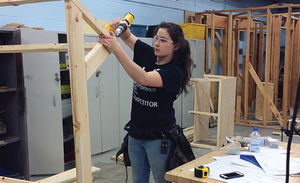Thousands of Jobs Await College Grads with Skilled Trades
Student Perspective According to Employment and Social Development Canada’s occupation projections; there are now 24 trades facing significant labour shortages.
Registrar and CEO, Ontario College of Trades
These shortages include the construction, electricity, oil and gas, mining, and automotive sectors. This demand for skilled workers could rise to a high of 3.9 million people by 2031.
This critical shortage means that both consumers and businesses are likely to pay more, wait longer for services, and experience costly delays to important infrastructure projects, such as roads, subways and hospitals.
Job security
With the Ontario unemployment rate hovering over seven percent, David Tsubouchi, Registrar and Chief Executive Officer of the Ontario College of Trades, reminds us that, “There is no such thing as job security today in the public or private sector. But when you learn a trade, you have real transportable skills you can take anywhere, make a great living and take control of your own career.”
“When you learn a trade, you have real transportable skills you can take anywhere, make a great living and take control of your own career.”
While there are no quick fixes to this problem, a few glaring facts are hard to ignore, including the underrepresentation of groups such as aboriginals, newcomers to Canada, and women in particular.
In fact, according to the Ministry of Training, Colleges and Universities, women account for only 2.5 percent of apprentices in the automotive sector, 2.3 percent in construction and 3.3 percent in the industrial sector.
New opportunities
Tsubouchi says, “there is a real opportunity for women, young people, and aboriginal communities in northern Ontario for example, with massive government investments in the Ring of Fire mining projects. It’s rewarding work and a chance to make a very good living too, we need more skilled workers.”
One example of a woman seizing the opportunity is 21 year-old Michelle Smaglinski. She’s now in her third year of the electrical apprenticeship program at Mohawk College in Hamilton. Smaglinski is more than half-way through her apprenticeship and says, “it’s rewarding work, I like the feeling of having accomplished something at the end of every day.”
The money is nice too. She’s being paid to learn and will graduate debt free. Several of her friends have a university degree and huge student loan debts. Many still can’t find jobs.
Nuclear energy
In the Canadian nuclear energy industry, their current workforce has less than 20 percent female representation, says Joy Shikaze, Executive Director of Women in Nuclear Canada (WiN-Canada). WiN-Canada promotes opportunities for women in the industry through mentoring, networking, and personal career development.
The nuclear industry is currently dominated by men. These workers are also reaching the end of their careers. These retirements mean a shortage of people who have the expertise to run nuclear power stations. Shikaze adds, “women can fill that gap, but we need to ensure that they get the necessary training and technical skills.”
Electricity industry
A big underrepresentation also exists in the electricity industry. The industry partly is also facing a critical shortage of workers. This lack of workers is due to retirements. It’s also due to increased demand from a massive $295 billion government investment. The investment will occur over the next 20 years to upgrade an aging electricity infrastructure, according to Michelle Branigan, Chief Executive Officer of Electricity Human Resources Canada (EHRC).
EHRC believes that attracting more women to the industry is a big part of the solution. “According to our research, while we have about 25 percent women working in the electricity sector, less than five percent of our tradespeople are women. It is crucial that utilities, educators, and government continue to work together to improve the representation of women in the electricity sector,” says Branigan.
College partnerships
According to Branigan, “the colleges have been great and are adapting to the changing needs of industry, to meet the job requirements of employers.”
This means graduates through their school and apprenticeship programs will be job ready. This is vitally important when you consider these are the people who keep the economy working and the lights on .
Heath Applebaum
[email protected]





.jpg)














